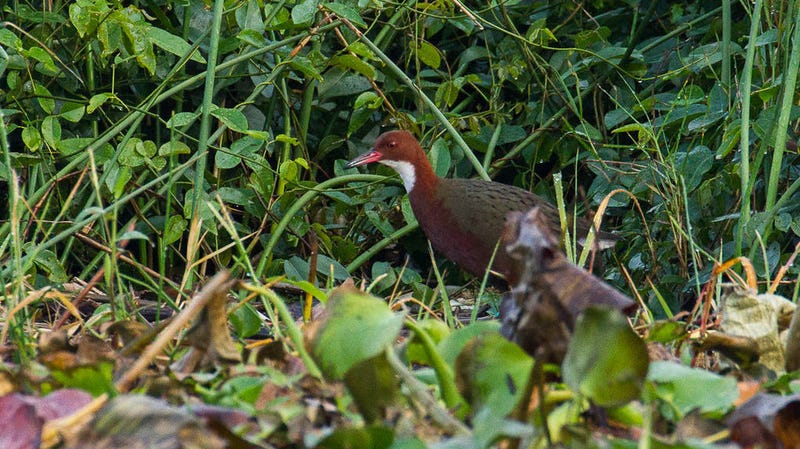Em algum momento entre 136.000 e 240.000 anos atrás, um bando de pássaros estranhos e desajeitados decolou de Madagascar e chegou a uma ilha intocada no atol de Aldabra, a 400 km de distância. “Isso é bom”, eles podem ter pensado - não havia predadores e os pássaros colonizaram a ilha. Sem a ameaça de predação, eles acabaram perdendo a capacidade de voar. Mas 136.000 anos atrás, uma inundação inundou a ilha, aniquilando esta única espécie que não voa.
Logo depois que a ilha ressurgiu, outro bando decolou de Madagascar e chegou a Aldabra - e a evolução ocorreu quase da mesma maneira.
Logo depois que a ilha ressurgiu, outro bando decolou de Madagascar e chegou a Aldabra - e a evolução ocorreu quase da mesma maneira.
Rails
are a family of flying birds you might see skulking around marshes, and
some rail species are known for dispersing quite far from their initial
homes. It’s not so surprising that the white-throated rail species
colonized a distant island—but a new paper documents perhaps the first
case of the same genus of rail colonizing the same island and then
evolving along the same trajectory in response.
“In 20,000 years
or less, the rails were evolving flightlessness again,” Julian Hume from
the Natural History Museum in the United Kingdom told Gizmodo.
“Evolution can be incredibly quick if the conditions are right.”
Or,
according to the research “Fossil evidence presented here is unique for
[rails] and epitomizes the ability of birds from this clade to
successfully colonize isolated islands and evolve flightlessness on
multiple occasions,” Hume and author David Martill at the University of
Portsmouth, both in the United Kingdom, write in the study published recently in the Zoological Journal of the Linnean Society.
The
researchers analyzed individual wing and leg fossils taken from the
island and held at the Smithsonian Institution National Museum of
Natural History and the Natural History Museum, London. This particular
island has the oldest paleontological record of any Indian Ocean island,
according to the paper. They compared the fossilized bones to
white-throated rail specimens from the Natural History Museum at Tring,
some originating from Malagasy birds that could fly and some from
Aldabran birds that had evolved such that they lost the ability to fly.
The
fossilized bones had almost the same measurements as the bones from the
flightless Aldabran birds, according to the paper. Essentially, the
wing bones were stunted and the leg bones were thicker, implying that
the old rail, too, was a flightless bird. There’s pretty solid evidence
that the Aldabran islands were completely submerged 136,000 years ago,
which would have wiped out the older rail population. But it seems
another population of rails returned and evolved the same
way—figuratively and perhaps literally following the same path as their
predecessors.
Let me take a moment to describe rails to you. They
are generally goofy, big-legged birds that spend most of their time
walking. They do not look like they should be able to fly, and they look
hilarious when they do. They’re also notorious for dispersing far and wide—they
just stop flying when they find someplace nice. The flightless rails
are “among the most species-rich examples of parallel evolution in
vertebrates” according to one paper.
It’s unclear why they occasionally seek out new environs, said Hume.
But the same genus, colonizing the same island, and evolving the same
way? That seems to be a first.
Other researchers were impressed
with the work. “It’s a very elegant analysis,” Martin Stervander, a
University of Oregon postdoctoral researcher who was not involved in the
study, told Gizmodo. “Both fossils look very much like the rails today.
We can clearly see that they are rail fossils, and that they were
flightless.”
But there’s a darker side to the story. The Aldabra
rail is the last surviving flightless bird in the Indian Ocean. “They’re
more vulnerable to extinction when they become flightless,” Julia
Heinen, Ph.D student at the University of Copenhagen, told Gizmodo.
“They’re not used to having predators. Then, when people arrive with
rats and cats and whatever else likes to eat birds, they can’t fly away
and go extinct much faster.” According to one estimate, between 440 and 1,580 flightless rail species went extinct following human colonization of Oceania.
As long as cats and rats are still on these islands, it’s unlikely that these re-evolution events will occur again.

Nenhum comentário:
Postar um comentário
Observação: somente um membro deste blog pode postar um comentário.